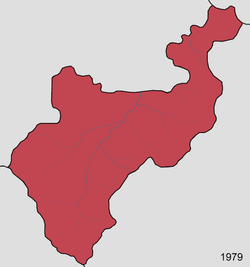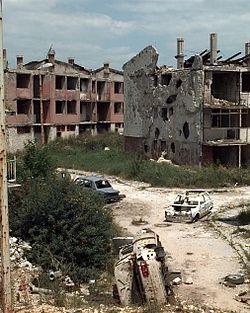User:Luziyca/Sandbox3
| Lemovician Civil War | |||||||
|---|---|---|---|---|---|---|---|
 Animated map of the Lemovician Civil War Lemovician government Miersan separatists (until 1985)/Opposition-separatist coalition (from 1985) Opposition forces (until 1985) | |||||||
| |||||||
| Belligerents | |||||||
|
Supported by: TBD |
TBDFile:MiersEntity.png Miersan separatists Supported by: TBD | ||||||
| Commanders and leaders | |||||||
|
|
File:LemovEntFlag.png Otxote Sasiambarrena File:LemovEntFlag.png Gizon Artalolea File:LemovEntFlag.png Xuban Urtizverea † File:LemovEntFlag.png Seniko Urdiaga | ||||||
| Strength | |||||||
|
|
| ||||||
| Casualties and losses | |||||||
|
Lemovician 30,521 killed 38,696 wounded 14,696 missing and captured |
West Miersan 15,359 killed 41,506 wounded 18,921 missing and captured | ||||||
|
c. 300,000 civilians killed 2,171,631 internally displaced persons and refugees | |||||||
The Lemovician War (Lemovician: Mendiluŕeko bijna, Miersan: Małomierska wojna), often known as the Little War (Lemovician: Bijna cikija, Miersan: Mała wojna) was a twelve-year long war of independence in Malomiersa and West Miersa, which lasted from 1979 until 1992.
(TBC)
Origins
The roots of the civil war are believed to begin with the industrialisation of present-day Lemovicia: due to the substantial coal and iron deposits present in the region, migrants, primarily from the Miersan Governorate of the Narozalic Empire, which at the time, ruled over both present-day West Miersa and Lemovicia. This allowed substantial migration of Miersans to Lemovicia, ultimately forming a substantial majority in the northern regions of Malomiersa by 1900.
Following the implementation of the Godfredson Plan in 1936 which granted Miersa independence as West Miersa and East Miersa, Lemovicia was placed under the control of the Miersan Federation, due to Lemovicia's long association with the Soravian Miersan Governate. Under West Miersan rule, the region underwent a policy of Miersanization, which had the effect of reducing the number of ethnic Lemovicians from 46% in 1936 to 34% in 1977.
In the 1970s, as coal and iron mines closed down in Malomiersa, tensions grew between Lemovicians and Miersans, as they competed for fewer and fewer jobs. This led to Lemovicians reasserting their identity against the Miersan majority, with two major organizations, Eztebe Tolaregain's Lemovician Cultural Alliance, and Nikola Lezana's Lemovician Section of the Workers' International become the two main Lemovician organizations. While the former primarily focused on a cultural revival, the latter sought a political solution to the plight of the Lemovician nation.
Prelude
From 1977 onward, terrorist attacks became a common feature of life in the region, with the first major one taking place in September of that year, when a bomb planted at a West Miersan government office in Sechia injured two people. While this was a lone wolf attack, in l978, the Aranoak was founded, with the express purpose of launching a campaign of terrorism to "cripple northern rule [over Lemovicia]."
Between October 1978 and November 1979, Aranoak committed six terrorist attacks, killing 19 people and injuring 55 people. In response, the West Miersan government engaged in extensive crackdowns against Lemovicians, which led to growing opposition to West Miersan rule.
However, shortly after East Miersa invaded West Miersa, thus starting the Miersan War, the Lemovician Section of the Workers' International took it upon themselves to seize control of government buildings in Mistózburó (present-day Topagunea) and proclaimed their independence from West Miersa on 21 November, 1979.
Events
Early phases

Active phase
Stalemate and renewed offensive
Operation Storm and Operation Michael

Final phases

Negotiations
Aftermath


